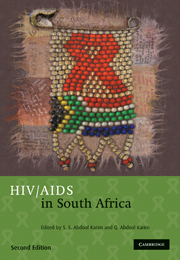Book contents
- Frontmatter
- Contents
- List of Contributors
- Foreword: Peter Piot
- Foreword: Nelson R Mandela
- Acknowledgements
- Section 1 Birth of a rapidly growing epidemic
- Section 2 The virus, the human host and their interactions
- 5 Viral structure, replication, tropism, pathogenesis and natural history
- 6 HIV diagnostics
- 7 HIV-1 genetic diversity
- 8 Cellular immunity in HIV: a synthesis of responses to preserve self
- Section 3 HIV risk factors and prevention strategiess
- Section 4 Focal groups for understanding the HIV epidemic
- Section 5 The impact of AIDS
- Section 6 Treating HIV
- Section 7 What does the future hold?
- Index
8 - Cellular immunity in HIV: a synthesis of responses to preserve self
Published online by Cambridge University Press: 07 September 2011
- Frontmatter
- Contents
- List of Contributors
- Foreword: Peter Piot
- Foreword: Nelson R Mandela
- Acknowledgements
- Section 1 Birth of a rapidly growing epidemic
- Section 2 The virus, the human host and their interactions
- 5 Viral structure, replication, tropism, pathogenesis and natural history
- 6 HIV diagnostics
- 7 HIV-1 genetic diversity
- 8 Cellular immunity in HIV: a synthesis of responses to preserve self
- Section 3 HIV risk factors and prevention strategiess
- Section 4 Focal groups for understanding the HIV epidemic
- Section 5 The impact of AIDS
- Section 6 Treating HIV
- Section 7 What does the future hold?
- Index
Summary
IN THIS CHAPTER SALIENT points are brought into focus concerning general immunity and immunity to HIV-1 infection. An effective and efficient immune response develops to preserve self from non-self and a discriminating recognition process has evolved to ensure this. HIV-1 has successfully undermined the discriminating process and leaves the infected host open to many diseases where there is no longer an ability to preserve self. However, some HIV-1 infected individuals do not progress to AIDS and others appear to be resistant to infection. These individuals are thought to mount highly effective immune responses that provide some form of protection. The objective of many research efforts has been and will be to determine what type of immunity these individuals develop.
There are already some clues that certain host genes, such as hla backgrounds, are important and that strong T-cell immunity develops in people who progress slowly. Additionally, it is thought that events in the first few months of hiv-1 infection are crucial to emulate with a vaccine – as it is the T-cell responses to recently transmitted viruses that are the most effective at controlling viral replication. It is likely that the most important point at which pathogenesis takes hold and there is a ‘point of no return’, is when hiv-1 seeds to the lymphoid depots and begins to precipitate lymphoid structure degeneration. At this point, drug intervention is the only mechanism that would allow the immune system to restore, as drug-induced viral suppression would allow lymphoid structures to regenerate.
- Type
- Chapter
- Information
- HIV/AIDS in South Africa , pp. 127 - 154Publisher: Cambridge University PressPrint publication year: 2010

